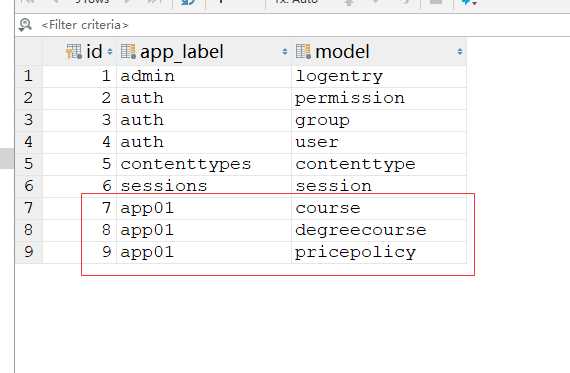标签:bsp strong rom from 技术分享 表名 shortcut 很多 分享
这是一个django内置的表结构,为的就是通过两个字段让表和N张表创建FK关系。

比如说有两种不同课程,这两种课程都有价格周期和策略。如果最低级的则是给每个表创建一个价格策略。如果非要在同一个表内使用价格策略,
那么如上图那样,course_id跟专题课程做外键关联,学位课程为空,如果跟学位课程做关联,那么专题课程的ID又为空,如果很多门课程,那么
就需要在价格策略中写入很多的外键字段。
为了解决这种问题,django引入了一种方式就是django的contenttypes。
首先有下面的表结构:
from django.db import models from django.contrib.contenttypes.models import ContentType from django.contrib.contenttypes.fields import GenericForeignKey, GenericRelation class DegreeCourse(models.Model): """学位课程""" name = models.CharField(max_length=128, unique=True) course_img = models.CharField(max_length=255, verbose_name="缩略图") brief = models.TextField(verbose_name="学位课程简介", ) class Course(models.Model): """专题课程""" name = models.CharField(max_length=128, unique=True) course_img = models.CharField(max_length=255) # 不会在数据库生成列,只用于帮助你进行查询 policy_list = GenericRelation("PricePolicy") class PricePolicy(models.Model): """价格与有课程效期表""" content_type = models.ForeignKey(ContentType,on_delete=models.CASCADE) # 关联course or degree_course object_id = models.PositiveIntegerField() #不会在数据库生成列,只用于帮助你进行添加和查询 content_object = GenericForeignKey(‘content_type‘, ‘object_id‘) valid_period_choices = ( (1, ‘1天‘), (3, ‘3天‘), (7, ‘1周‘), (14, ‘2周‘), (30, ‘1个月‘), (60, ‘2个月‘), (90, ‘3个月‘), (180, ‘6个月‘), (210, ‘12个月‘), (540, ‘18个月‘), (720, ‘24个月‘), ) valid_period = models.SmallIntegerField(choices=valid_period_choices) price = models.FloatField()
这种结构就相当于下图:

另外建立一个表,存放表名称。
然后在价格策略表中放2个字段,一个字段就是表名,一个就是这个表中第几个数据。
比如course表中第一个数据21天入门。
表结构分析:
content_type = models.ForeignKey(ContentType,on_delete=models.CASCADE) # 关联course or degree_course
object_id = models.PositiveIntegerField() #这个就是课程表内有多少课程,这个约束不了,只能是个正整数。

最后就是查询和增加的测试!
from django.shortcuts import render,HttpResponse from app01 import models from django.contrib.contenttypes.models import ContentType def test(request): # 1.在价格策略表中添加一条数据 # models.PricePolicy.objects.create( # valid_period=7, # price=6.6, # content_type=ContentType.objects.get(model=‘course‘), #外键关联到这个表 # object_id=1 # )
#使用神奇的字段创建
# models.PricePolicy.objects.create( # valid_period=14, # price=9.9, # content_object=models.Course.objects.get(id=1) #这样得到就是Course表,而且id是1,这两个。自动帮你添加这两个值。 # )
# 2. 根据某个价格策略对象,找到他对应的表和数据,如:管理课程名称 # price = models.PricePolicy.objects.get(id=2) #ID为2的这条价格策略对象 # print(price.content_object.name) # 关联的是专题课程,想要显示专题课程的名称 21天入门
# 3.找到某个课程关联的所有价格策略 数据库中加这个 policy_list=GenericRelation("PricePolicy") # obj = models.Course.objects.get(id=1) # for item in obj.policy_list.all(): # print(item.id,item.valid_period,item.price) # # return HttpResponse(‘...‘)
加的两个字段使用的关系以及使用django.content-type表的使用:

不仅是价格策略,优惠券也会使用这个,比如2种类型的课程,买第一种课程的有优惠券,买第二种课程还可能有优惠券。
标签:bsp strong rom from 技术分享 表名 shortcut 很多 分享
原文地址:https://www.cnblogs.com/geogre123/p/9803315.html